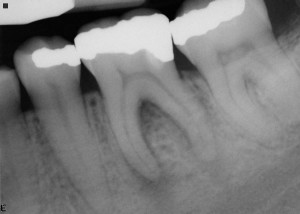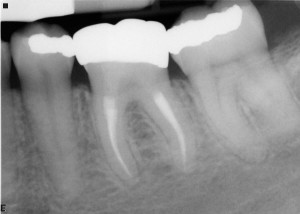Gum disease affects almost 1 in 5 adults but is the commonest cause of tooth loss amongst all adults which means that those who have gum disease lose far more teeth than those who do not. What determines whether you are in the (almost) 20% of the population who get gum disease is largely down to genetics but how much gum disease you end up getting is hugely affected by how well you clean your teeth and whether you smoke or not (smokers lose three times as many teeth as non-smokers). The aim of all treatment for gum disease is to reduce and control inflammation in the gums, primarily though improved cleaning and home care by the patient. Countless clinical studies over the past 5 decades have shown that regular supportive work from a hygienist and special treatment from a periodontal specialist improves the outcome in patients with gum disease. In patients with advanced gum disease, however, we eventually have to ask ourselves and the patient “when do we give up on a tooth and just take it out”? The answer to this question is often more tricky to provide then you might, at first, think, but an excellent study detailed below offers some helpful insight. Dentistry is all about making these choices and, perhaps most importantly, about the dentist giving the right information to the patient so that they can make the right choice for themselves.
The study was reported last year in the Journal of Clinical Periodontology and reported on an 18-year follow-up of almost 400 patients with gum disease looking at over 2000 molar teeth to see what influenced their survival and it helps to give us a much clearer idea of which teeth are worth fighting for. The shortened version of the results tells us that we must look at not just how advanced the gum disease is but also how heavily filled the tooth is and whether it has had a root canal filling or not (only bad root fillings have a negative impact, not ones that were done well). In molar teeth, if the bone has dropped to below the level where the roots divide ( an area known as the furcation) then the prognosis gets worse for the tooth the more that bone is lost here. It is really important, therefore, that any patient who shows early signs of bone loss in this particular region acts quickly to improve their gum health to prevent this site from worsening. This study showed, however, that even allowing for advanced bone loss in the furcation region of molars the outcome at 18 years was an almost 75% retention of all molars. Other similar studies have reported even higher survival rates of up to 86% which means that with the right level of care from both hygienists and periodontal specialists we can help patients maintain their teeth for many years, even when they have experienced advanced levels of gum disease. With this in mind, the answer to “when should we give up” is “much later than you might think”. Excellent daily home care coupled with optimal root canal fillings where appropriate and ideal restorations combined with hygiene and specialist care will give survival rates comparable to all other replacement options (implants, bridges or dentures) and usually for a lower cost.


We are so lucky at StoneRock to have access to our Periodontal Specialist Dr Mitchelle Mbaeri and also to have the opportunity to provide high standard root canal fillings coupled with an outstanding hygiene team as this means that we can offer patients every chance of keeping their teeth for many years, even in the face of advanced gum disease. If you are worried about your gums or think that you may need a root canal filling then please call us in 01580752202 and one of our reception team will be happy to help.